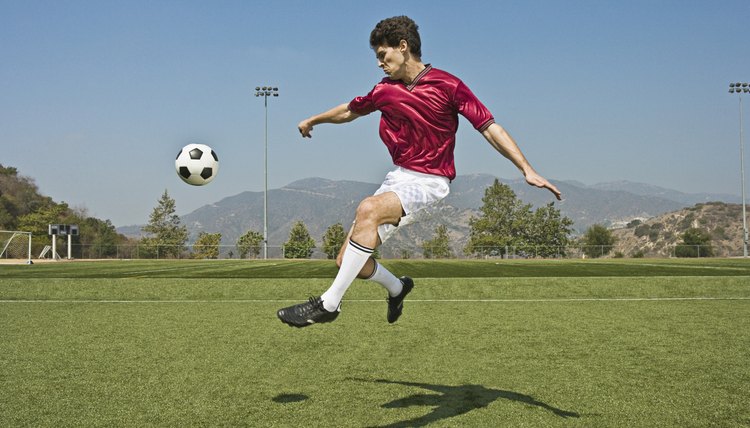What does fact checked mean?
At SportsRec, we strive to deliver objective content that is accurate and up-to-date. Our team periodically reviews articles in order to ensure content quality. The sources cited below consist of evidence from peer-reviewed journals, prominent medical organizations, academic associations, and government data.
- Journal of Athletic Training; Ankle Braces Effectively Reduce Recurrence of Ankle Sprains in Female Soccer Players; Sharon Sharpe et al.
- Journal of Athletic Training; Ankle Braces Effectively Reduce Recurrence of Ankle Sprains in Female Soccer Players; Sharon Sharpe et al.
The information contained on this site is for informational purposes only, and should not be used as a substitute for the advice of a professional health care provider. Please check with the appropriate physician regarding health questions and concerns. Although we strive to deliver accurate and up-to-date information, no guarantee to that effect is made.
What Do Soccer Players Do for Ankle Support?

Ankle injuries account for about 20 percent of all sports injuries, notes Roald Bahr, a prominent researcher of sports medicine at Oslo Sports Trauma Research Center in Norway. Similarly, the journal Pediatrics found that ankle injuries account for 16 percent to 29 percent of soccer injuries among child and youth players, and affect males more. Soccer players looking for ankle support need to balance the need to avoid ankle re-injury with the sport’s demands for exceptionally fluid foot movements.
Types
Soccer players with no history of ankle injuries typically do not use ankle support. Those with previously injured ankles might use either nothing for ankle support, a canvas lace-up brace, taping or a neoprene sleeve. A study by Sharon Sharpe, head athletic trainer of Wellesley College and published in the Journal of Athletic Training in 1997, found that the ankle sprain recurred in 35 percent of soccer players with untreated ankles, 25 percent of those with the taped ankles and 0 percent for those wearing braces. The study did not address neoprene braces. Sharpe and colleagues write that while the taping of ankles to protect against sprains is nearly universal, the ability of tape to restrict the ankle’s range of motion becomes compromised as its use continues, losing 18 percent to 83 percent of its ability to restrict range of motion. Reasons include sweat, which reduces adherence to the skin, and mechanical failure.
Significance
For roughly a century, soccer players wore actual boots with high tops that protected and supported the ankles. Beginning in the 1950s, shoemakers in Europe, led by dominant market presence Adidas, made low-top shoes instead that permitted running, as Brazil’s track-meet style based on light touches of the ball gained influence. Low-tops permitted wider movement of the subtalar joint in the ankle, a vulnerable area for soccer player, especially for defenders during corner kicks, Bahr notes.
Function
Supports such as canvas lace-ups or neoprene sleeves allow free motion in terms of walking or running, such that the toe can point up or down, but restrict against supination or pronation, essentially side-to-side rolling motions. A canvas brace slips over your ankle and lower shin; lace it so that it provides firm support without limiting your circulation. Taping involves creating “stirrups” under the heel and around the forefoot and locking these with half or whole figure eights around the heel.
Time Frame
An ankle brace or tape should be worn during soccer practice and games at least until the completion of a supervised rehabilitation program, including six to 10 weeks of balance-training exercise, Bahr recommends. Most athletes find bracing more comfortable than tape and more cost-effective. Soccer players find foot control essential and may resist using ankle braces. “I've played all my life and only used ankle supports -- a neoprene sleeve and a canvas brace -- when very injured, but never otherwise,” says Tim Almaguer, a player and youth coach in Baltimore, Maryland. “You get zero touch when the ankle is restricted. I am an offensive midfielder, and it is all about flexibility and quick first touch on the ball in close quarters.”
References
- Sports Injury Prevention; Roald Bahr, Lars Engebretsen
- Clinical Guide to Sports Injuries; Roald Bahr, Sverre Mæhlum
- Pediatrics; Injuries in Youth Soccer; Chris G. Koutures et al.
- Journal of Athletic Training; Ankle Braces Effectively Reduce Recurrence of Ankle Sprains in Female Soccer Players; Sharon Sharpe et al.
- The Biomechanics of Soccer Surfaces and Equipment in Science and Soccer; Adrian Lees and Mark Lake
- The American Journal of Sports Medicine; Ankle Sprain Injuries and Risk Factors in Amateur Soccer Players During a 2-Year Period; Nikolaos D. Kofotolis
Writer Bio
An award-winning writer and editor, Rogue Parrish has worked at the Washington Post, the Baltimore Sun and at newspapers from England to Alaska. This world adventurer and travel book author, who graduates summa cum laude in journalism from the University of Maryland, specializes in travel and food -- as well as sports and fitness. She's also a property manager and writes on DIY projects.
